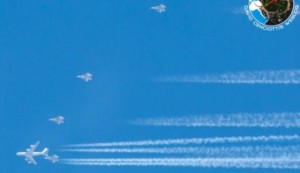 U,S, last Aril deployed six F-22 Raptors, its most advanced fighter currently in operational use and the only operational 'stealth' fighter in use around�the world, on airbase in UAE. This temporary deployment has apparently become permanent.
U,S, last Aril deployed six F-22 Raptors, its most advanced fighter currently in operational use and the only operational 'stealth' fighter in use around�the world, on airbase in UAE. This temporary deployment has apparently become permanent.
The United States significantly upgraded its strike capabilities in the Persian Gulf last week when it stationed in the United Arab Emirates (UAE) six F-22 "stealth" fighters with advanced strike features.
In the past, the U.S. had insisted that it was temporarily stationing the fighters in the Gulf on deployments that had been planned long in advance. It now seems that the deployment has become permanent while the fighters capabilities have been enhanced.
The deployment of six F-22 Raptor fighters last April at the Al-Dhafra Airbase in UAE, 150 kilometers from Iranian territory caused a flurry of reports on the buildup of American forces in the Persian Gulf before a possible strike against Iran's nuclear installations.
The F-22 is the most advanced fighter currently in operational use by the United States Air Force and the only operational "stealth" fighter in use around the world with the capability to evade enemy radar systems. A USAF spokesman said at the time that "this is a very normal deployment" which was scheduled in advance and "not a threat to Iran." Such a deployment usually lasts for a few months and the planes return to their home base.
Last week, the six F-22s returned after nine months - a rather long deployment - to the 49th Fighter Wing's Holloman Base in New Mexico. But they did not leave the UAE before being replaced by six other F-22s, this time from the 3rd Fighter Wing which flew all the way from Elmendorf-Richmond Base in Alaska. The fact that after such a long deployment, the Americans are keeping up the presence of these advanced fighters in the Persian Gulf indicates that this is not a routine sojourn but rather a more permanent presence aimed at a possible conflagration in Iran.
The F-22 was designed as an air-superiority fighter and has been in operational service for a decade and is the most expensive fighter in history - $150 million for each plane. The high price lead the Obama administration to decide in 2010 to end procurement of the plane and end its production in late 2011 after only 187 fighters (due to its secret systems, the F-22 was not authorized for export) had been delivered to the USAF, despite initial plans to buy 750. Due to its huge cost, the F-22 has yet to be used in combat. The maintenance of the plane, which has experienced more than its fair-share of technical problems, is also extremely high-cost, due among other factors to the need to maintain and periodically replace the "radar absorbing" materials which coat it. A lengthy deployment, far from American shores puts a heavy burden on the U.S. military.
In addition to the F-22's extended deployment to the Persian Gulf, the other significant development is the fact that the newly arrived fighters are of a more advanced version than those they replaced. The 3rd Fighter Wing's jets were the first to undergo a software upgrade to the 3.1 version which allows the F-22 to carry eight "smart" bombs and launch them simultaneously at four separate targets at super-cruise speed and without losing its stealth capability. With the upgrade, the air fleet's most advanced fighter jet, designed for air-to-air combat, can now also carry out pinpoint ground attacks against a number of "quality" targets in one mission.
The replacement of the F-22 in the UAE with even more advanced fighters was not accompanied by an official announcement from the Pentagon or published in the media. The flight of the advanced planes over Europe was seen by an Italian photographer during aerial refueling and�published in The Aviationist, a blog on aeronautical matters. In addition, the landing of the fighters en route at the Lajes Airbase on the Azores was noted by airplane spotters.
The upgrade of American strike capabilities in the Persian Gulf is taking place at the same time the American Administration is seeking to lower the tensions in the region over the Iranian nuclear issue. President Barack Obama said last Sunday in the inauguration speech opening his second term that "a decade of war is now ending" while his appointment of Senator Chuck Hagel, a staunch opponent of war against Iran, as the next Defense Secretary, is a signal that the administration will do its utmost to avoid a strike. On the other hand, the heavy investment by the Americans in preparing military options proves that this alternative is still on the table if needed. Over the weekend, Defense Minister Ehud Barak said in�an interview with the Daily Beast�that the administration has prepared plans for surgical attacks on Iran. "The Pentagon prepared quite sophisticated, fine, extremely fine, scalpels," said Barak. "So it is not an issue of a major war or a failure to block Iran. You could under a certain situation, if worse comes to worst, end up with a surgical operation."
By Haaretz
The Iran Project is not responsible for the content of quoted articles.

 QR code
QR code